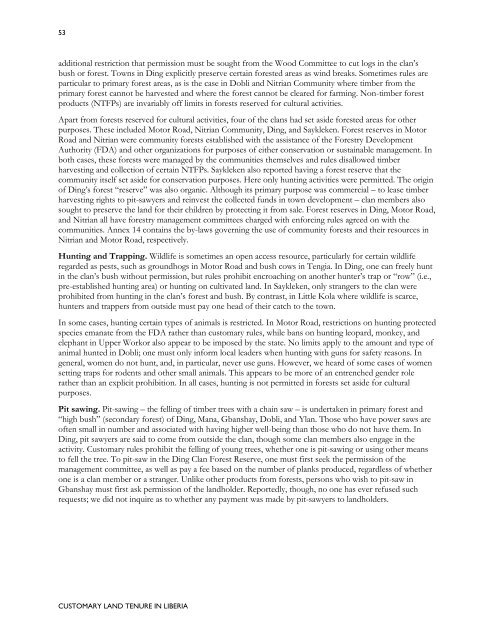Customary Land Tenure in Liberia - Land Tenure and Property ...
Customary Land Tenure in Liberia - Land Tenure and Property ...
Customary Land Tenure in Liberia - Land Tenure and Property ...
You also want an ePaper? Increase the reach of your titles
YUMPU automatically turns print PDFs into web optimized ePapers that Google loves.
53<br />
additional restriction that permission must be sought from the Wood Committee to cut logs <strong>in</strong> the clan‟s<br />
bush or forest. Towns <strong>in</strong> D<strong>in</strong>g explicitly preserve certa<strong>in</strong> forested areas as w<strong>in</strong>d breaks. Sometimes rules are<br />
particular to primary forest areas, as is the case <strong>in</strong> Dobli <strong>and</strong> Nitrian Community where timber from the<br />
primary forest cannot be harvested <strong>and</strong> where the forest cannot be cleared for farm<strong>in</strong>g. Non-timber forest<br />
products (NTFPs) are <strong>in</strong>variably off limits <strong>in</strong> forests reserved for cultural activities.<br />
Apart from forests reserved for cultural activities, four of the clans had set aside forested areas for other<br />
purposes. These <strong>in</strong>cluded Motor Road, Nitrian Community, D<strong>in</strong>g, <strong>and</strong> Saykleken. Forest reserves <strong>in</strong> Motor<br />
Road <strong>and</strong> Nitrian were community forests established with the assistance of the Forestry Development<br />
Authority (FDA) <strong>and</strong> other organizations for purposes of either conservation or susta<strong>in</strong>able management. In<br />
both cases, these forests were managed by the communities themselves <strong>and</strong> rules disallowed timber<br />
harvest<strong>in</strong>g <strong>and</strong> collection of certa<strong>in</strong> NTFPs. Saykleken also reported hav<strong>in</strong>g a forest reserve that the<br />
community itself set aside for conservation purposes. Here only hunt<strong>in</strong>g activities were permitted. The orig<strong>in</strong><br />
of D<strong>in</strong>g‟s forest “reserve” was also organic. Although its primary purpose was commercial – to lease timber<br />
harvest<strong>in</strong>g rights to pit-sawyers <strong>and</strong> re<strong>in</strong>vest the collected funds <strong>in</strong> town development – clan members also<br />
sought to preserve the l<strong>and</strong> for their children by protect<strong>in</strong>g it from sale. Forest reserves <strong>in</strong> D<strong>in</strong>g, Motor Road,<br />
<strong>and</strong> Nitrian all have forestry management committees charged with enforc<strong>in</strong>g rules agreed on with the<br />
communities. Annex 14 conta<strong>in</strong>s the by-laws govern<strong>in</strong>g the use of community forests <strong>and</strong> their resources <strong>in</strong><br />
Nitrian <strong>and</strong> Motor Road, respectively.<br />
Hunt<strong>in</strong>g <strong>and</strong> Trapp<strong>in</strong>g. Wildlife is sometimes an open access resource, particularly for certa<strong>in</strong> wildlife<br />
regarded as pests, such as groundhogs <strong>in</strong> Motor Road <strong>and</strong> bush cows <strong>in</strong> Tengia. In D<strong>in</strong>g, one can freely hunt<br />
<strong>in</strong> the clan‟s bush without permission, but rules prohibit encroach<strong>in</strong>g on another hunter‟s trap or “row” (i.e.,<br />
pre-established hunt<strong>in</strong>g area) or hunt<strong>in</strong>g on cultivated l<strong>and</strong>. In Saykleken, only strangers to the clan were<br />
prohibited from hunt<strong>in</strong>g <strong>in</strong> the clan‟s forest <strong>and</strong> bush. By contrast, <strong>in</strong> Little Kola where wildlife is scarce,<br />
hunters <strong>and</strong> trappers from outside must pay one head of their catch to the town.<br />
In some cases, hunt<strong>in</strong>g certa<strong>in</strong> types of animals is restricted. In Motor Road, restrictions on hunt<strong>in</strong>g protected<br />
species emanate from the FDA rather than customary rules, while bans on hunt<strong>in</strong>g leopard, monkey, <strong>and</strong><br />
elephant <strong>in</strong> Upper Workor also appear to be imposed by the state. No limits apply to the amount <strong>and</strong> type of<br />
animal hunted <strong>in</strong> Dobli; one must only <strong>in</strong>form local leaders when hunt<strong>in</strong>g with guns for safety reasons. In<br />
general, women do not hunt, <strong>and</strong>, <strong>in</strong> particular, never use guns. However, we heard of some cases of women<br />
sett<strong>in</strong>g traps for rodents <strong>and</strong> other small animals. This appears to be more of an entrenched gender role<br />
rather than an explicit prohibition. In all cases, hunt<strong>in</strong>g is not permitted <strong>in</strong> forests set aside for cultural<br />
purposes.<br />
Pit saw<strong>in</strong>g. Pit-saw<strong>in</strong>g – the fell<strong>in</strong>g of timber trees with a cha<strong>in</strong> saw – is undertaken <strong>in</strong> primary forest <strong>and</strong><br />
“high bush” (secondary forest) of D<strong>in</strong>g, Mana, Gbanshay, Dobli, <strong>and</strong> Ylan. Those who have power saws are<br />
often small <strong>in</strong> number <strong>and</strong> associated with hav<strong>in</strong>g higher well-be<strong>in</strong>g than those who do not have them. In<br />
D<strong>in</strong>g, pit sawyers are said to come from outside the clan, though some clan members also engage <strong>in</strong> the<br />
activity. <strong>Customary</strong> rules prohibit the fell<strong>in</strong>g of young trees, whether one is pit-saw<strong>in</strong>g or us<strong>in</strong>g other means<br />
to fell the tree. To pit-saw <strong>in</strong> the D<strong>in</strong>g Clan Forest Reserve, one must first seek the permission of the<br />
management committee, as well as pay a fee based on the number of planks produced, regardless of whether<br />
one is a clan member or a stranger. Unlike other products from forests, persons who wish to pit-saw <strong>in</strong><br />
Gbanshay must first ask permission of the l<strong>and</strong>holder. Reportedly, though, no one has ever refused such<br />
requests; we did not <strong>in</strong>quire as to whether any payment was made by pit-sawyers to l<strong>and</strong>holders.<br />
CUSTOMARY LAND TENURE IN LIBERIA

















